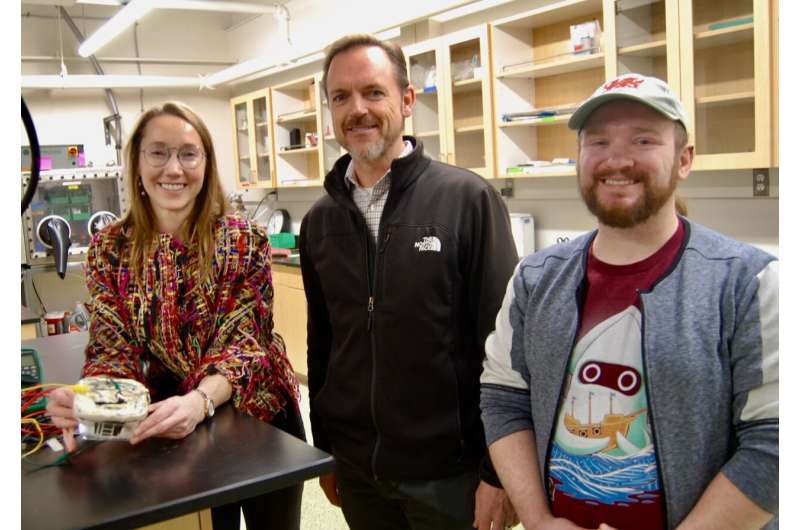Today wirelessly connected devices are performing an expanding array of applications, such as monitoring the condition of engines and machinery and remote sensing in agricultural settings. Systems known as the “Internet of Things” (IoT), hold much potential for improving the efficiency and safety of the equipment.
Yet stumbling blocks remain for IoT, thwarting many potential applications. How do you power these devices in situations where and when reliable electrical sources are not practically available?
Research from the University of Utah’s College of Engineering points to a possible solution in the form of a novel type of battery called a pyroelectrochemical cell (PEC).
The device was developed and tested in the research labs of Roseanne Warren and Shad Roundy, both associate professors of mechanical engineering.
“It’s our idea for an integrated device that could harvest ambient thermal energy and convert it directly into stored electrochemical energy in the form of a supercapacitor or battery with applications for the Internet of things and distributed sensors,” said Warren, the senior author on a new study that demonstrates a proof of concept.
“We’re talking very low levels of energy harvesting, but the ability to have sensors that can be distributed and not need to be recharged in the field is the main advantage,” she added. “We explored the basic physics of it and found that it could generate a charge with an increase in temperature or a decrease in temperature.”
The study is published the journal Energy & Environmental Science
The device is charged by changing temperatures in the surrounding environment, whether it’s inside a car or aircraft or just under the soil in an agricultural environment. In theory, the PEC could power sensors for IoT applications that would otherwise be impractical to recharge.
A solar cell would work fine in some situations, according to Roundy, a co-author of the study.
“But in a lot of environments, you run into two problems,” said Roundy. “One is that it gets dirty over time. Solar cells have to be kept clean. So in these types of applications, they get dirty and their power degrades. And then there are a lot of applications where you just don’t have sunlight available. For example, we work on soil sensors that we put just under the top surface of the soil. You’re not going to get any sunlight.”
The PEC uses a pyroelectric composite material, as the separator in an electrochemical cell. The material consists of porous polyvinylidene fluoride (PVDF) and barium titanate nanoparticles. This material’s electrical properties change as it’s heated or cooled, which decreases or increases the polarization of the pyroelectric separator

Changing temperatures create an electric field inside the cell, pushing ions around and enabling the cell store to energy.
“It stores electricity in what’s called an electric double layer, which stores the charge in positive and negative layers of ions. This is a glorified capacitor,” said lead author Tim Kowalchik, a graduate student in Warren’s lab. “When you heat and cool the system and you’re storing electrochemical energy, you’re changing the amount of positive or negative ions that are in those layers.”
The new study tested the lab’s theory of how the cell would operate.
“We had a predicted model of function that included what we called an ‘orientation effect’ in the paper,” Kowalchik said. “If we change the reverse the orientation of separator in the cell, it should drive ions the other way. This is a change we can make to the system that will show a different result that we can gather.”
The team’s experiments were set up to determine if the cells would respond as they predicted. Besides the orientation effect, there were heating vs. cooling effects that needed to be tested.
“If you heat the thing one way, you should get something to happen. If you cool it first, you should get something to happen and that should show up differently,” Kowalchik said. “We did that with a process called amperometry. You put a voltage across it and you hold that voltage constant and measure current. Your energy into the system is constant if nothing changes; if there is energy going into the system, the current changes.”
The cell did respond as the team theorized it would, but can it work outside a lab? That’s the next question Warren seeks to address. One of her students is now undertaking circuit modeling to design a cell and optimize its function.
“Now we start to change different parameters,” Warren said. “How can we improve the energy harvesting and storage and the combination of the two? And then after that would be a real-world field demonstration.”
The cell could produce up to 100 microjoules per square centimeter from a single heating/cooling cycle, which is not much energy, but enough to be useful for IoT purposes, according to the research.
“You want to monitor the condition of your car, the condition of machines, the condition of plants and soil and those kinds of things. Those types of sensors are generally going to be quite a bit lower power than your smartwatch or your phone, which have a display and they’re transmitting a lot of data,” Roundy said. “The sensors we’re talking about might just give periodic updates and they operate autonomously. They don’t have an interface or a screen.”
More information:
Tim Kowalchik et al, Direct conversion of thermal energy to stored electrochemical energy via a self-charging pyroelectrochemical cell, Energy & Environmental Science (2024). DOI: 10.1039/D3EE03497F
Citation:
This device gathers, stores electricity in remote settings (2024, April 9)
retrieved 9 April 2024
from https://techxplore.com/news/2024-04-device-electricity-remote.html
This document is subject to copyright. Apart from any fair dealing for the purpose of private study or research, no
part may be reproduced without the written permission. The content is provided for information purposes only.

